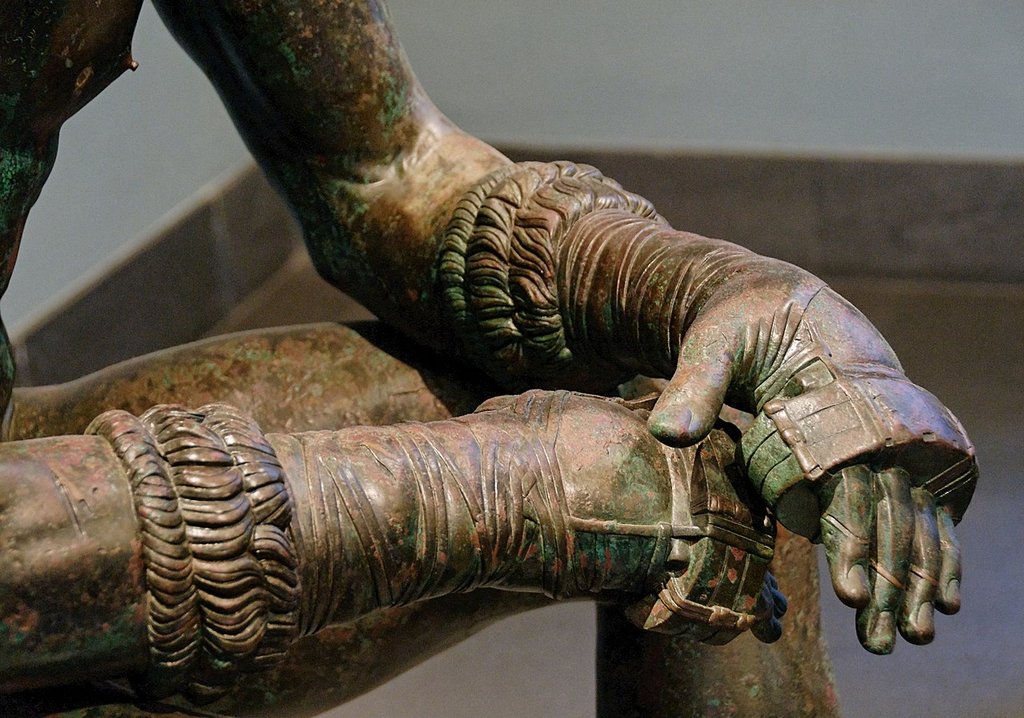Today we will tell you a little about the history of the caestus, ancient boxing glove, which is present in the battles since the roman age.
As you can imagine, the human being has always felt the need to have physical confrontations, whether for sport, fun or survival.
And that’s how the caestus was born, an ancient boxing glove, with which one a great damage could be inflicted on its opponents, in addition to protecting the fists of the competitors.
Discover how the caestus was, since when it was used, how it was used and when it had its decline, if you are passionate about boxing, you cannot miss the beginnings of boxing gloves.
CAESTUS HISTORY
From the moment the body fighting was born, human beings, especially men, sought ways to improve their defenses and attacks.
And being the fundamental hands and knuckles during the fights, they soon found a way to protect them and give them greater impact strength.
If we go back to its etymological root, the word caestus comes from the Latin word, which derives from the verb caedere which means to beat or to hit.
CAESTUS PRECEDENTS
The history of the caestus goes back to the times of the Greek empire and later of the Roman empire, when the bloody battles in open fields were not enough and the public asked to see men fighting in the pancracy.

In the second century, Greeks were the first to protect their fists and knuckles with thick leather strips that tied their hands to that aim. With them they could fight until one of the two opponents was exhausted, knocked out or dead, while the hands were protected as far as possible.
[adsense]
He was the son of Poseidon, Amycus, king of the barbarians in Anatolia, who is credited with the invention of hand protections, such as boxing gloves; and was recognized by Clement of Alexandria himself, a prominent member of the Catholics at that time.
CAESTUS WAS BORN WITH THE ROMANS
Subsequently, the Roman gladiators also adopted the leather strips to protect their hands and knuckles, however, the encounters were so exhausting, that they had to think of something else.
That was how the caestus were born; the Roman gladiators, in an eagerness to be more forceful in their battles in the pancracy, added metal plates in their fists, supported by leather strips. The result was overwhelming, especially because they fought mainly against unarmed slaves.
The most iconic image of the caestus can be seen in the sculpture Boxer at rest, which remains in Rome, in the Massimo alle Término Palace.
WHAT IS CAESTUS?
We can say then that the caestus is the evolution of simple leather strips, and the first precedent for boxing gloves.

The caestus resulted in an incredible weapon that caused great fury for the damage it caused to the fighters, mainly those who had no weapons and were only «cannon fodder» to entertain the crowds.
The caestus also marked the precedents for the current iron boxers, popularly used in street fights with great effectiveness.
You could even say that they were the inspiration for multiple similar later inventions, such as iron gloves. An example is the powerful glove of Thanos or the unforgettable claws of Wolverine.
WHO USED CAESTUS AND HOW?
The Roman gladiators were the only ones who used caestus in their beginnings. They managed to make leather gloves that reached the middle of the forearm, with two metal plates held with the same leather on the knuckles of the boxers.
[adsense]
They soon became so effective that their sadism aroused great commotion among those attending the pancracy during the Ancient Olympic Games.
It is even mentioned that the faces of the most unfortunate opponents ended up shattered, ground and disfigured. In addition to presenting multiple internal wounds, especially in the intestines and broken ribs, because of the strong impacts with the metal plates.
BRUTALITY AND DECLIVE OF CAESTUS
For some time the gloves of caestus enjoyed great popularity, were a kind of barbarism applauded and feared at the same time. With which, some of the fiercest Roman gladiators became a legend in the pancracy.
However, there came a time when the brutal effectiveness of the Caestus gloves wounded more than the faces and bodies of thousands of slaves and gladiators.
And suddenly, in the face of his insurmountable superiority, the caestus became a weapon that humiliated degradingly until the death, to the thousands of slaves who perished in front of them without any similar protection.
DECLIVE OF THE CAESTUS
Finally, the caestus were banned in the first century before Christ, moving back to the clean fist fight.
[adsense]
They reached its decline a century after its splendor in the melee, because they had also become one of the main objectives of the bets between men, causing other problems.
Sometime later, in the year 393, hand-to-hand struggles were also banned, as a sign that brutality is not so much in the complements, but in the opponents’ own impetus.
HOW WERE THE CAESTUS GLOVES?
As can be seen in some vestiges of Greek and Roman paintings, in addition to sculptures preserved in perfect condition, caestus had the following characteristics.

They were narrow gloves that perfectly fit the hands of their wearers, the strips of softened leather covered up to the forearm. And the stiffer leather was at the top, where the knuckles meet a careless face.
In addition, the part of the fist was reinforced with iron plates, metal parts and skewers to hold them firmly. While the fingers were free to attack, defend, tear down and do various maneuvers with free fingers.
And that was how the precedents of the first boxing gloves in the history of boxing sat down.
Did you like this article? Share it!
👉🏼👉🏼 Share this 💚💚🙏🏻🙏🏻:
